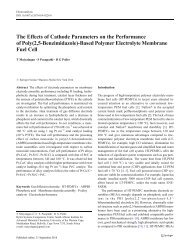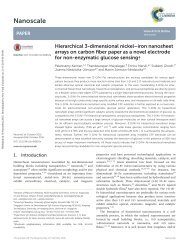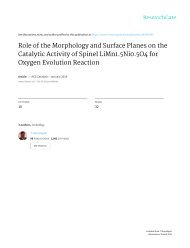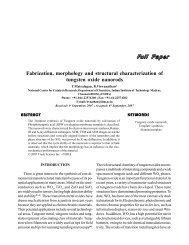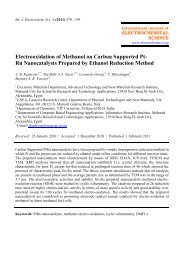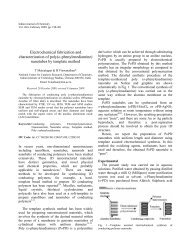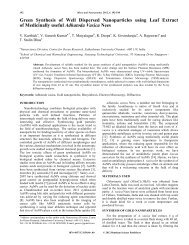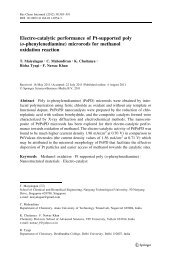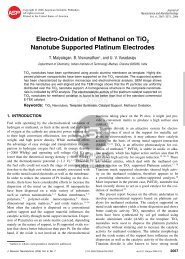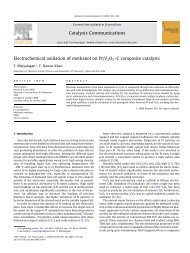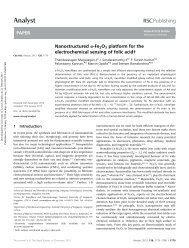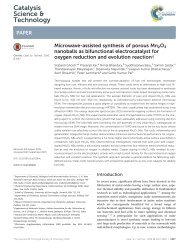2013 Nano Energy
Create successful ePaper yourself
Turn your PDF publications into a flip-book with our unique Google optimized e-Paper software.
One-pot synthesis and enhanced electrocatalytic activity of chain-like palladium nanocubes<br />
679<br />
Figure 1 FE-SEM images of (a) simple branched chain-like cubic Pd nanostructures using 5-HT (0.1 mM), (b) a portion of image “a”,<br />
(c) a portion of image “b” and (d) a portion of image “c”.<br />
prepared at a conc. of 0.1 mM 5-HT, the FE-SEM images were<br />
taken after 1 and 5 h time interval and presented in<br />
Figure 2a–c. From the FE-SEM measurements the density,<br />
length and number of cubic branches per nanochains were<br />
almostsameoverthegrowthperiodupto5h(Figure 2aandb).<br />
These time-dependent features can be ascribed either to the<br />
aggregation of nanoparticles or the growth of anisotropic<br />
nanostructures. The morphology of cubic chain-like Pd nanostructures<br />
remained the same even after 5 h, implying that the<br />
observedfeatureisnotduetotheaggregationofnanoparticles.<br />
The chain-like Pd nanocubes grow up to the size of 80 mm<br />
with more than 25 branches in 5 h (Figure 2d). The observed<br />
results suggest that the cubic chain-like morphology is highly<br />
stablebyvaryingthetimeintervals(both30min,1and5h).To<br />
the best of our knowledge, this is the first report that describes<br />
rapid eco-friendly synthesis of cubic chain-like Pd nanostructures<br />
(branches in a tree) at room temperature without any<br />
heat treatment, template, polymer, or surfactant. The overview<br />
of the mechanism for formation of such a unique shape<br />
can be outlined in Scheme 1 as: (i) in the initial stage of<br />
reaction, Pd 2+ ions are reduced by 5-HT to form nano-sized<br />
small Pd cubic shaped nanoparticles (around 5–10 min), (ii) a<br />
homogeneous nucleation of these cubic nanoparticles forms<br />
small, primary Pd cubic nano-chains by gradual assembly of<br />
these particles that grows into a one-dimensional interconnected<br />
nanostructure and a complete growth of cubic chainlike<br />
nanostructures was observed after 30 min of reaction<br />
(iii) these primary particles undergo nucleation/assemble due<br />
course over time into a 1-D nanostructure and reconstruction of<br />
these small nanocubes into cubic dendritic nanowires [36,37].<br />
We propose that, 5-HT molecule (stabilising/reducing agent)<br />
plays a vital role on selective binding on the surface of<br />
1-D nanostructure and reconstruct the tiny nanocubes into<br />
dendritic-like nanochains. The growth of nanostructured particles<br />
is highly perceptive to the concentration of 5-HT and<br />
precursor, Pd 2+ (Figure 3). Here we demonstrate that cubic<br />
chain-like Pd nanostructures, cubic small dendrites of Pd<br />
nanostructures, cubic big-dendrites of Pd nanostructures and<br />
fractal Pd nanostructures could be selectively prepared by<br />
manipulating and controlling the concentration of 5-HT and<br />
Pd 2+ (Figures 4, 5 and Figure S1). It should be noted here that<br />
this procedure establishes a universal protocol for synthesis of<br />
monodisperse Pd nanostructures with a variety of shapes<br />
without adopting different strategies, reaction conditions, or<br />
injection of foreign reagents. Minor change in the concentrations<br />
of stabilizer and a fixed concentration of precursor or<br />
vice versa results in the formation of different morphologies of<br />
the nanoparticles assembly (Figure 3).<br />
Recently, Willner and co-workers have reported the cataecholamine<br />
neurotransmitters mediated growth of Au nanoparticles<br />
and their quantification by optical method [38]. The<br />
catacholamine neurotransmitters and their metabolites induce<br />
thegrowthofsphericalshapenanoparticles,andtheydonot<br />
induce the formation of any anisotropic nanoparticles [38]. In<br />
the present investigation, we observed cubic Pd nanochains,<br />
cubic nanostructures of big-dendrites, and fractal nanostructures<br />
by the indoleamine neurotransmitter. The formation of<br />
chain-like nanostructured particles is attributed to the oxidation<br />
of 5-HT by PdCl 2 .AsshowninScheme 2, reduction of<br />
PdCl 2 occurs due to the transfer of electrons from HT to the<br />
metal ion, resulting in the formation of Pd 0 . The metallic Pd<br />
then undergoes nucleation and growth with time to form cubic<br />
chain-like Pd nanostructures, cubic nanostructures of dendrites<br />
and fractal nanostructures. It is well documented in the




